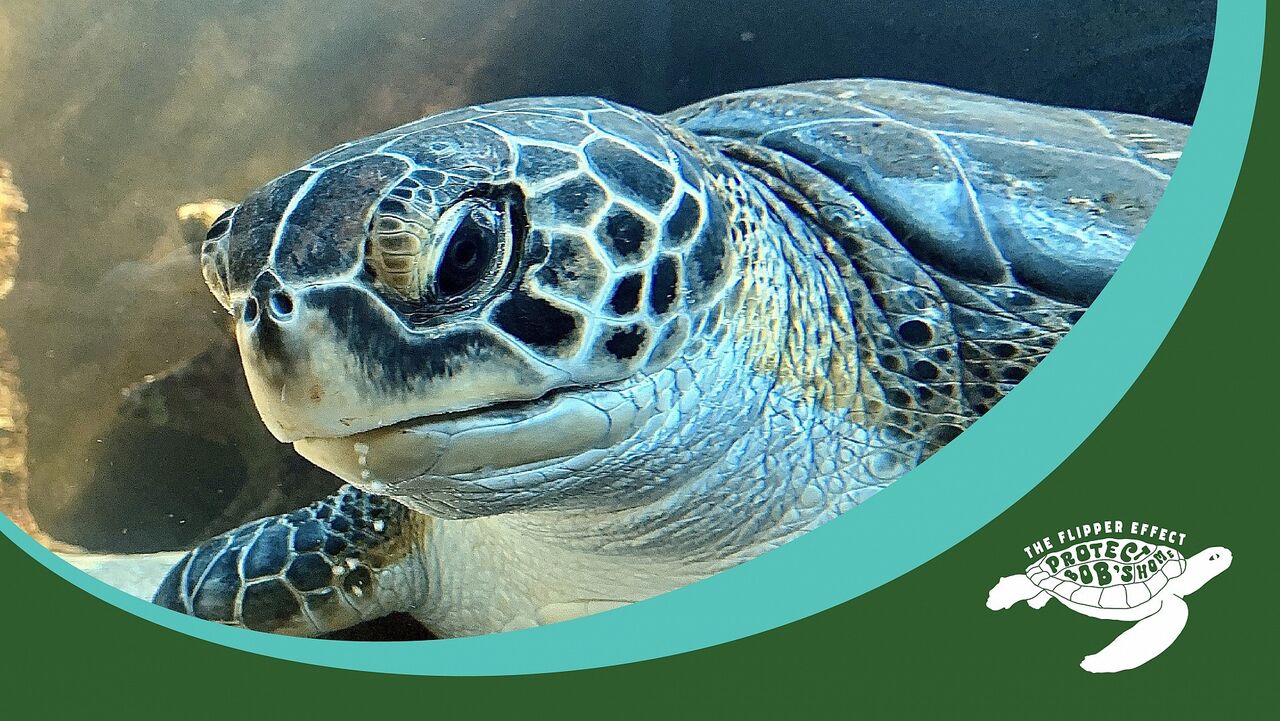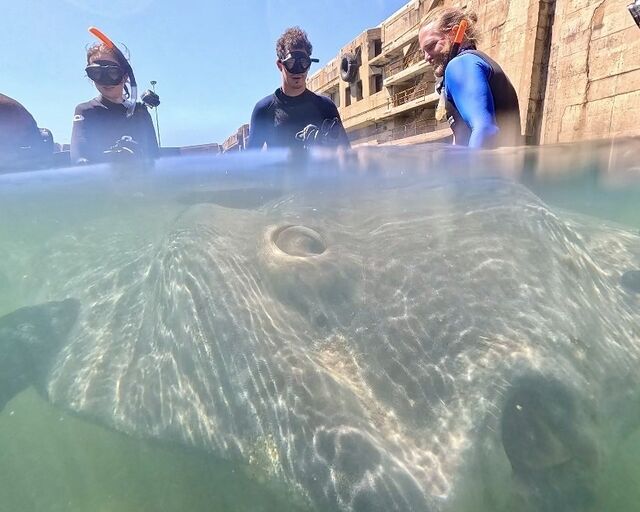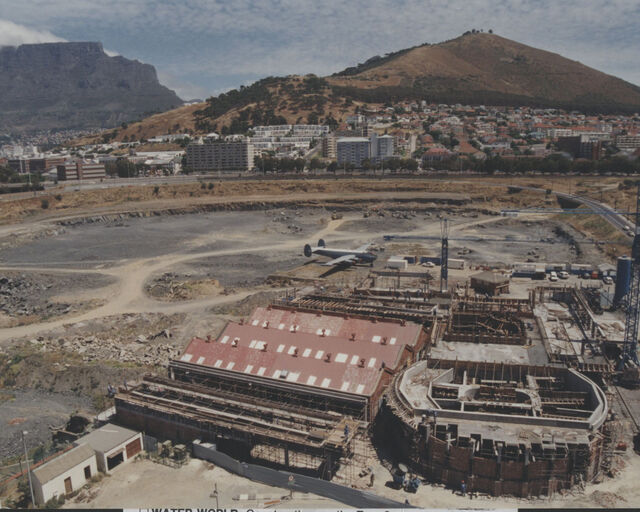This blog is part of a series about Bob, written by the Two Oceans Aquarium Foundation's turtle conservation team, with the hopes that it motivates Bob-lovers to help us protect our oceans of all turtles. Learn more about this campaign at the bottom of this blog - The Flipper Effect: #ProtectBobsHome.
Everyone who has visited the Two Oceans Aquarium knows Bob, an endangered green sea turtle resident in our I&J Ocean Exhibit. Bob has been such a long-term feature of the Aquarium, that we sometimes forget that he's actually a rehabilitation patient, with the intention of one day being healthy enough to complete his path to release back into the wild.
Bob has stolen the show at the Two Oceans Aquarium for half a decade, but it's time for this much-loved "shellebrity" to take the next step in his journey of recovery. Credit: Martine Viljoen
Bob's story holds many meanings for everyone that has had the opportunity to experience his presence; whether through a school visit, scuba dive, sleepover or members' event, Bob clearly holds a unique space in the memories of many. Bob's resilience has made him Cape Town's "celebrity turtle", but his near-death encounter with ocean plastic pollution is a wake-up call for how our consumption at home affects the natural world.
To answer the question "Who is Bob?", let's revisit Bob's origin story and take a closer look at why this special turtle is at the Aquarium, and what his future holds in the care of the Two Oceans Aquarium Foundation's turtle team.
Bob on arrival at the Aquarium. Image courtesy of Dr Georgina Cole
Bob arrived into our care on 6 November 2014 as an injured sub-adult green turtle (Chelonia mydas) and was delivered into the hands of the Two Oceans Aquarium team weighing just 16.6kg (in contrast to their now 85.6kg strong)!
Initial Rescue Details:
- Rescuers: Rescued by Lieze Swart of Oceans and Coasts and transported through to Cape Town by Darrell Anders from the Department of Forestry, Fisheries and the Environment
- Location: De Hoop Nature Reserve, about four hours from Cape Town (which is now noted as a hotspot for our sub/adult larger turtle strandings )
- Reason for stranding: Suffered from severe bruising and a possible fracture of the bottom shell (or plastron), with loss of scales, and exposed bone and was positively buoyant, floating in the rehab tank inspiring their chosen name Bob.
- Initial treatment: Conducted full examination (X-rays and bloodwork), wounds cleaned and bandaged, received freshwater baths to rehydrate, antibiotics and pain relief
Bob's rehabilitation rollercoaster had only just begun! Bob’s fractured plastron developed an infection. At the time, we suspected that bacteria from these injuries had spread to his blood, and ultimately his brain, causing encephalitis and inflammation. Unfortunately, this resulted in brain damage, with Bob's vision and ability to perform many of the natural behaviours necessary for survival severely compromised.
But, on 6 January 2015, exactly three months into our care, we discovered the true cause of the problem - Bob pooped out several single-use plastic bags and balloons, some with their strings still attached! Unfortunately, this isn’t an isolated case for Bob - it is common for turtles to mistake floating plastic for food. These ingested plastics result in bowel obstructions leading to many recorded fatalities across several marine species.
The photo below of Bob’s ingested plastics has touched thousands upon thousands of people – with Bob acting as an incredible ambassador and messenger for the human-induced plastic crisis in the ocean. We're confident Bob’s message will continue long after they’re released back into the wild!
The balloons Bob had swallowed. Image courtesy of Renée Leeuwner
What makes Bob releasable now?
Although his external wounds healed, Bob's brain damage affected some of the natural species-specific behaviours typical of wild turtles that are considered essential for survival. Until recently, it was the opinion of veterinary experts that Bob would not be able to survive in the wild.
But, this status has changed! With an intensive enrichment programme designed to stimulate Bob's mental activity and "rewild" him, we've seen slow, but steady improvement in Bob's behaviour – a re-awakening of his natural behaviours. This improvement has led us to believe that Bob is, in fact, releasable and the Two Oceans Aquarium Foundation team has worked tirelessly to get Bob release-ready.
Bob during an enrichment activity. Credit: Justin Blake
But, this still did not mean Bob's release was guaranteed - he needed to meet a number of strict criteria before this. These criteria include displaying more aggressive feeding and territorial behaviours, random exploratory swimming, resting at the bottom of the I&J Ocean Exhibit, evidence of spatial and depth perception, and healthy neurological responses.
Given time, Bob has been able to overcome these obstacles and proved his resilience to us. Bob really highlights the ultimate driving goal of the Two Oceans Aquarium Foundation's turtle rehabilitation work - to release every one of our recovered patients back into the wild.
Bob has shown drastic improvement from initial assessments and with effective enrichment activities. He is now capable of skillfully manoeuvring around obstacles and, although he is slightly short-sighted, he is not prevented from tracking and foraging for necessary food items beneath and at the water's surface. Following physiological and neurological tests, our veterinarians and Animal Ethics Committee have now cleared Bob for release.
We’re counting down the days leading to Bob finally returning to his ocean home!
The Flipper Effect: Protect Bob's Home
Bob is at the brink of release back into the borderless wilds of the open ocean after eight years of difficult rehabilitation. As we are preparing to release him, we realise we won't be able to protect him anymore.
The reality is simple: The ocean is not safe for turtles.
Together we can change that. Bob will be facing many of the same human-caused threats that resulted in his stranding in the first place, and which are the cause of harm to the overwhelming majority of distressed sea turtles - plastic pollution, habitat destruction, careless use of fishing equipment.
In order to create an ocean that is safe for Bob and all other creatures that call it home, we must continuously take small actions towards protecting it - these small actions compound into big change. This is #TheFlipperEffect!
Related News
Sign up to our Newsletter
Receive monthly news, online courses and conservation programmes.





